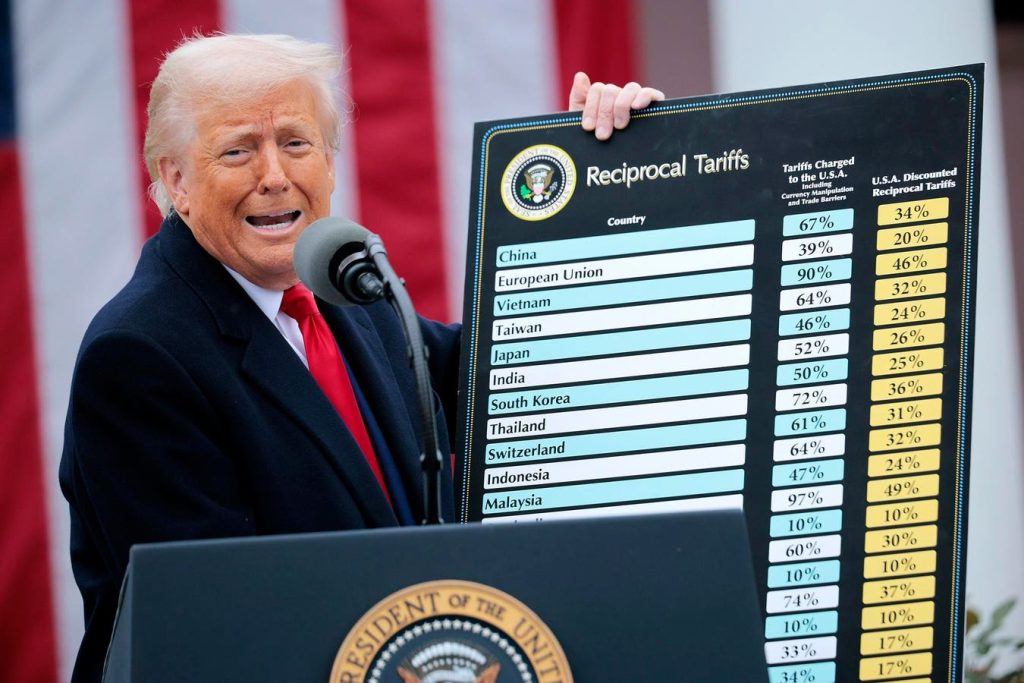WASHINGTON, DC – APRIL 02: U.S. President Donald Trump holds up a chart at his tariff announcement … More
President Donald Trump’s tariffs will generate far less tax revenue than the administration claims, according to a new Tax Policy Center estimate, even as import taxes disrupt stock markets and the world economy.
Peter Navarro, a senior trade official in the White House, projected tariffs announced since January would generate about $6 trillion to $7 trillion over 10 years. A tax increase of that magnitude would generate enough revenue to fund an extension of the 2017 Tax Cuts and Jobs Act as well as some of Trump’s campaign promises, such as tax-free tips, overtime, and Social Security benefits.
Falling Far Short
But Trump’s tariffs are likely to fall far short of Navarro’s prediction, leaving a gaping fiscal hole for Congress to fill as it tackles a major tax bill this year. TPC estimates Trump’s taxes on imported goods would raise about $3.3 trillion from 2026 to 2035, plus an additional $190 billion for the remainder of 2025, roughly half of Navarro’s prediction. TPC’s projection excludes the effects of tariffs imposed on U.S. goods by trading partners in retaliation for Trump’s import taxes.
Several factors will significantly reduce the net revenue collected from tariffs, including:
- Purchasers will respond to higher prices on imported products by buying fewer of them, thus significantly reducing the amount of taxed imports.
- Trading partners already have announced retaliatory tariffs on U.S. goods, which would slow U.S. exports, harm domestic producers of those products, reduce employment, and lower corporate and individual income tax and payroll tax revenue.
- While some U.S. firms will benefit from tariffs, many will pay higher prices for parts and other intermediate goods, which will shrink profits, reduce employment, and also lower domestic tax revenue.
TPC’s analysis includes the effects of lower income and payroll tax revenues. However, it does not estimate the effects of retaliation or how much an expected decline in corporate profits and wages would slow the economy. If it did, tariff revenues would be even lower.
Paying For Tax Cuts
The Tax Policy Center estimates extending the TCJA would add $4.4 trillion to the national debt over the next decade. Interest on the additional debt would cost another $800 billion. Tax-free tips would cost at least $6.5 billion in 2025 alone, while exempting Social Security benefits from tax would reduce federal revenues by $1.5 trillion over a decade.
The Senate is considering a budget framework that would cut taxes by about $5.3 trillion. If not offset by tariffs or other tax increases, or by substantial cuts in federal spending, the Senate fiscal plan would increase the national debt to 134 percent of Gross Domestic Product in a decade.
The $6 trillion in new revenue Navarro claims may come from some simple math. The U.S. imported about $3.3 trillion in goods last year. Twenty percent of that (a rough estimate of all the Trump tariffs) is about $600 billion annually, or $6 trillion over a decade.
Conflicting Goals
Simple. But wrong. That gross number ignores the economic impact of tariffs and glosses over Trump’s conflicting goals.
If higher tariff-driven import prices reduce demand for foreign products, Trump will achieve his aim of boosting U.S. production. But if demand for those goods falls, so will tariff revenue.
By contrast, if U.S. buyers continue to purchase imports regardless of higher prices, the tariffs would raise a substantial amount of money. But Trump would fail to achieve his vow to grow U.S. manufacturing.
A third outcome is that Trump and U.S. trading partners eventually agree to lower tariffs, which would reduce revenue from the import tax but also soften the blow to U.S. businesses, consumers, and workers.
Washers And Autos
Trump’s tariffs not only will raise the cost of imports but also result in higher prices on competing domestic goods, reducing after-tax incomes of consumers of those products.
For example, when Trump raised tariffs on washing machines in his first term, prices of imported washers predictably went up. But so did prices of domestic washers and even of dryers, which were not even tariffed.
Similarly, higher prices on imported cars and parts will have cascading effects that are likely to slow the U.S. economy and lower tax revenues.
Tariffs on imported vehicles and parts will raise the cost of new domestic autos, which include foreign components. And higher costs for replacement parts also means repairs on foreign and domestic vehicles will cost more. As those expenses rise, so will automobile insurance premiums.
Breaking supply chains, where components often cross borders multiple times, also means less work for U.S. parts suppliers, truck drivers, and the businesses that service them–from gas stations to restaurants.
Eventually, the U.S. economy will adjust to higher tariffs. But that will take many years.
Until then, the negative effects of import taxes such as rising unemployment and a slowing economy will drain trillions of dollars from the revenues the administration hopes to raise. And it will leave the president far short of paying for the tax cuts he demands.

